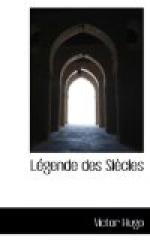perhaps beyond the power of any single poet to accomplish,
and was certainly one for which he was not altogether
well fitted. He did not possess that capacity
for taking a broad and impartial view of history which
was needed in the author of such an epic as he designed.
His strong predilections on the one hand, and his
violent antipathies on the other, swayed his choice
of subjects, narrowed his field of vision, and influenced
his manner of presentment. The series cannot therefore
pretend to philosophic completeness. It is a gallery
of pictures painted by a master-hand, and pervaded
by a certain spirit of unity, yet devoid of any strict
arrangement, and formed on no carefully maintained
principle. It is a set of cameos, loosely strung
upon a thread, a structure with countless beautiful
parts, which do not however cohere into any symmetrical
whole. The poems are cast in many forms; allegory,
narrative, vision, didactic poetry, lyric poetry, all
find a place. There is little history, but much
legend, some fiction, and a good deal of mythology.
The series was not designed as a whole. La Chanson
des Aventuriers de la Mer was written in or before
1840, Le Mariage de Roland, Aymerillot,
and La Conscience in or about 1846, and other
pieces at intervals between 1849 and 1858, the date
at which the poet appears to have begun the task of
building these fragments into an epic structure.
Nor is there in these poems any dispassionate attempt
to portray the character of the successive ages in
the life of the race. For Hugo there was no ‘emancipation
du moi.’ The Legende is less a revelation
of history than it is a revelation of the poet.
His choice of themes was dictated less by a careful
search after what was most characteristic of each
epoch than by his own strong predilections. He
loved the picturesque, the heroic, the enormous, the
barbarous, the grotesque. Hence Eviradnus,
Ratbert, Le Mariage de Roland. He
loved also the weak, the poor, the defenceless, the
old man and the little child. Hence Les Pauvres
Gens, Booz endormi, Petit Paul.
He delighted in the monstrous, he revelled in extremes,
and he had little perception of the lights and shades
which make up ordinary human character. Neither
his poems nor his romances show much trace of that
psychological analysis which is the peculiar feature
of so much modern literature. Child of the nineteenth
century, as he was in so many respects, in many of
the features of his art he belongs to no era, and
conforms to no tendency, except that of his own Titanic
genius. He could see white and he could see black,
but he could not see grey, and never tried to paint
it. He does not allow Philip II even his redeeming
virtues of indefatigable industry and unceasing devotion
to duty, while in his Rome of the decadence would
assuredly be found scarce five good men. His
vision is curiously limited to the darker side of history;
he hears humanity uttering in all ages a cry of suffering,




